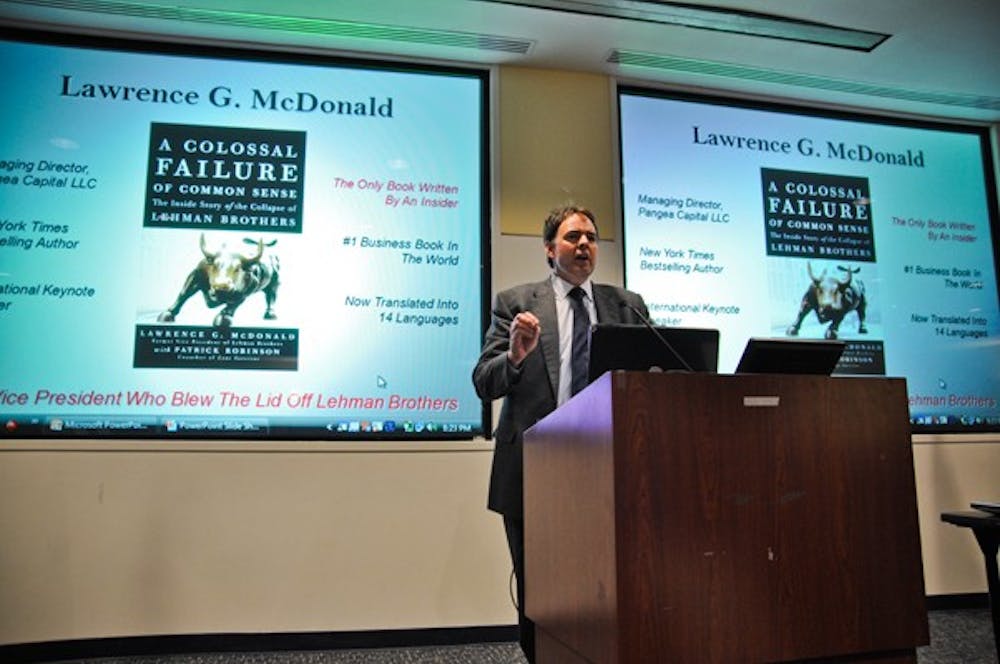A former vice president of Lehman Brothers said the inadequacy of the financial services firm’s Board of Directors to handle contemporary economic conditions was a significant factor in the firm’s downfall.
Lehman Brothers’ bankruptcy filing in September 2008 was the largest in U.S. history, according to MarketWatch’s Web site, and furthered the subprime mortgage crisis and the global economic downturn.
“The theater was on fire,” Larry McDonald said at the Feb. 24 Kennedy Political Union event. “And our CEO, Richard Fuld, was ordering more popcorn.”
| A conversation with Larry McDonaldHOWIE PERLMAN / THE EAGLE |
The Board of Directors helped Lehman Brothers become an enabler of the subprime mortgage crisis, according to McDonald. They were not sufficiently familiar with the implications and consequences of certain recently created methods of issuing and exchanging loans, especially mortgage loans, he said.
The board decided to concentrate most of the firm’s assets on commercial real estate, despite the urgings of employees within Lehman Brothers as early as 2004, to reduce the firm’s presence in the market for subprime mortgages, McDonald said.
Lawrence B. Lindsey, who chaired the National Economic Council from 2001 to 2002 and was later hired by Lehman Brothers to analyze its activities, warned the Board in late 2006 of growing concerns regarding so-called “NINJA” mortgages. NINJA is an acronym for subprime mortgages being lent to people who had “no income, no job, no assets,” according to McDonald.
Lehman Brothers’ rapid growth in the assets it was managing further hampered its ability to operate properly, McDonald said. The firm had total assets of $42 billion and $36 billion in debt at the end of fiscal year 1998. It had total assets of $691 billion and debt of $669 billion at the end of fiscal year 2007, according to the firm’s balance sheets filed with the U.S. Securities and Exchange Commission.
McDonald said he feels financial services firms of Lehman Brothers’ size should be considered as too big to properly succeed rather than “too big to fail.”
“They’re too big to be managed,” McDonald said in an exclusive interview with The Eagle before the KPU event. “Bank of America, today, is like a snake that has swallowed 5,000 rats ... I don’t care how smart you are, I don’t care if you put 10 analysts on Bank of America, I’m telling you right now, you cannot judge the risks on that balance sheet.”
Bank of America had $2.2 trillion in assets at the end of fiscal year 2009 with $2.0 trillion in debt, according to a balance sheet filed with the SEC on Feb. 26.
Alessandra Conti, a sophomore in the School of Communication, said she appreciated McDonald’s efforts to educate the public about the state of Lehman Brothers before it filed for bankruptcy.
“In spite of all this corruption, there are people who are willing to take a step back and look at the situation and be able to expose it,” Conti said. “In order to make change, you have to acknowledge what happened in the past.”
McDonald is touring the country to promote greater financial responsibility. His book, “A Colossal Failure of Common Sense: The Inside Story of the Collapse of Lehman Brothers,” provides further analysis and recommendations.
The next KPU event will be held this Wednesday, March 3 in MGC 4-5, and will feature Dunya Mikhail, an Iraqi poet and former literary editor for The Baghdad Observer.
You can reach this staff writer at hperlman@theeagleonline.com.





